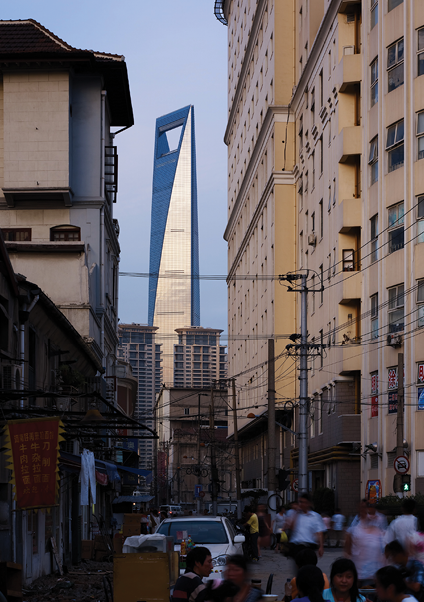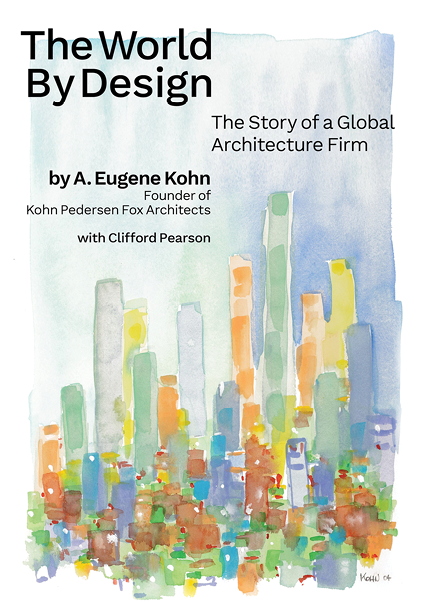- Home
- Media Kit
- Current Issue
- Past Issues
- Ad Specs-Submission
- Ad Print Settings
- Reprints (PDF)
- Photo Specifications (PDF)
- Contact Us

![]()
ONLINE

The Impact of Architecture
Editors’ Note
On July 4, 1976, A. Eugene Kohn founded Kohn Pedersen Fox Associates (KPF) in New York City, alongside William Pedersen and Sheldon Fox, with a commitment to outstanding design, quality of execution, and exceptional client service.
The Founding Partners wanted to create a firm that would succeed well past their own tenures. With this in mind, they sought talented people who could be as good, and ideally better, than themselves. These employees, mentored by the founders, would be the next leaders at KPF – and hold the responsibility of doing the same for following generations.
Today, Kohn serves as Principal and Chairman of Kohn Pedersen Fox. Holding Bachelor of Architecture and Master of Architecture degrees from the University of Pennsylvania, he served in the U.S. Navy on active duty between his academic degrees and, after graduation, remained in the Reserve for another five years, retiring as a Lieutenant Commander. He is an Executive Fellow of the Graduate School of Design at Harvard University where he teaches, in addition to teaching at Harvard Business School. He helped establish the Harvard Real Estate Center Academic Initiative, is a founding member of the Wharton School Real Estate Center Advisory Board, and has served for over 30 years on the Board of Overseers at PennDesign. Kohn was a trustee for the University of Pennsylvania and was honored with the 2010 Alumni Award of Merit by the university, the highest award presented to alumni. Kohn has also been recognized with the Wharton Real Estate Center’s Lifetime Achievement Award, the University of Pennsylvania – PennDesign Dean’s Medal of Achievement, the highest honor awarded by the institution, and the Ellis Island Medal of Honor.
Firm Brief
Operating as one firm with nine offices in eight countries, KPF (kpf.com) is one of the world’s premier architecture firms with over 650 staff members from numerous countries, together speaking a collective 40+ languages. The firm’s diverse portfolio comprises corporate headquarters, office buildings, hospitality, academic, medical, research, civic, museum, transportation, airports, bus and train stations, residential and mixed-use projects, both in the United States and abroad. More than 100 of the firm’s completed projects are LEED designated, or pursuing, green certification.

Hudson Yards on Manhattan’s West Side
What is the state of KPF’s business and where do you see the greatest opportunities for growth?
There are always opportunities for growth, so even though the markets may be changing, even that change creates opportunity. KPF’s market is across the country and most of the world, including Asia, Europe, South America and China. Almost half of our work is now in China. Being a global firm with expertise in diverse types of buildings has allowed us to handle all kinds of business conditions. So when the U.S. economy went into recession in the early 1990s, for example, we stayed busy in London, Europe and parts of Asia. When we started the firm, we worked mostly for corporate clients like ABC, Procter & Gamble, and AT&T. Today, we also work with developers, academic institutions, governmental agencies, airport authorities, museums and lots of other kinds of clients.
We are very busy in the United States. New York, Seattle, San Francisco, Los Angeles and San Jose have all been strong markets, as well as Boston, Washington and Philadelphia. How long this will last, I can’t tell you. I wouldn’t hazard a guess at this point, but there will come a time when things slow down.
Hudson Yards in New York City has done fantastically well and is almost fully leased in every building. I am not sure anyone would have guessed that Hudson Yards would have done that well, except maybe Steve (Ross, Chairman and Founder, Related Companies) or Jeff (Blau, CEO, Related Companies) or Bruce (Beal, President, Related Companies). It has done amazingly well and has had a huge positive impact on New York, healing an open wound in the city’s urban fabric and creating a new mixed-use neighborhood.
With KPF’s global footprint, how have you structured the firm in order to service global markets?
Today, we’re working in 40 countries. We have offices in London, Berlin, Singapore, Shanghai, Seoul, Hong Kong, Abu Dhabi and San Francisco, as well as New York. We are global in our reach, but we have great talent working across the country, and we do a lot of work out of New York that goes to China, or from London to China, although our offices in Hong Kong or Shanghai will carry out the work. We probably have over 200 buildings completed in China since we started – major buildings in Shenzhen, Shanghai, Beijing and many other cities. China has been a great opportunity for us.
The firm was built with a clear culture and a built-to-last mentality. When you experience the growth that KPF has achieved, is it challenging to maintain culture?
We have a lot of partners and a lot of teams. We have 31 partners based all around the world. We have put together phenomenal talent. If you compare it to a sports team, it’s like being three or four deep in each position, and if you substitute you would not know the difference, they are all so good. We have people who have been here 35 years – who have built rewarding careers here, which is great. So we have created a team feeling. People feel that they are part of a group. We didn’t do it in one day.

Shanghai World Financial Center in China
Will you discuss the impact of architecture and how it touches so many areas of human emotion?
Buildings affect you every day: your office, your home, a hospital or a school. The way it works, the lighting, the colors, the natural light, the feeling of the space, it can make you feel happy or sad, less tense or more tense. The work of architects affects so many people – these buildings that sometimes last 100 or more years, and the number of people who experience them, both from outside and inside, are affected by these buildings. If it’s a really great building, it makes you feel good. It makes you feel good about yourself.
Stanley Marcus (Neiman Marcus) was a client and a good friend. He said the key to the success of space is that it makes you feel good about yourself. So his idea always was to make his stores make you feel happy and feel positive and then you’ll buy.
This is true with hospitals as well. It used to be that when you went to a hospital it was dark gray, like battleships, and you didn’t feel optimistic and if you didn’t feel sick, you began to feel sick. But today, the new hospitals focus on how you, the patient, can recover by feeling positive and hopeful.
How critical is the developer-architect relationship to the success of a building?
There has to be mutual respect. There has to be a certain degree of decency and honor. Developers are creative and the New York developers are very experienced. Hudson Yards with Related and One Vanderbilt with SL Green are great examples of that.
What advice do you offer young people interested in a career in architecture?
They should recognize that they have a lot to learn. We probably do more teaching at KPF than most schools. Almost every other night, we hold some type of class about technology or design or you can learn from sculptors or artists who come in to talk to us. So there are always events and things to do here, and we make it possible to grow and improve.
You really need to have an open mind to learn and ask questions. When I was young, I worked for terrific firms, and during every lunch hour I would go and look at other jobs by other people in the firm. I looked at how they did their drawings. During construction, I would go out to the project site and see how it was being built and talk to the contractors. In other words, I was interested in all aspects.
So the individual has to want to learn and grow, and we try to make it easy for them to do that.

You are publishing a book titled – The World By Design, The Story of a Global Architecture Firm. What interested you in writing the book?
Somebody said, “You should write a book.” I think it was that simple. Our partners also thought that it would be good to have the history of the firm, how we got started, our philosophy, what we’ve done – in a book. So I thought it was a good idea, and I had been thinking about it anyhow. The book traces the full arc of my career – from my studies with Lou Kahn at Penn and my days working for other architects to the founding of KPF and its transformation into a global practice.
It’s a book of stories – stories about how we got started, about the talented people who work at KPF, and some of the remarkable clients we’ve collaborated with – such as Steve Ross at Hudson Yards, Marc Holliday who is building One Vanderbilt and Minoru Mori who created Roppongi Hills in Tokyo. It’s about events – good stories with good endings and some stories with not so good endings, but they were all part of the making of the firm and the experience of the firm. The book really deals with how this firm grew and operates. Most important, it’s about the new generation of leaders at KPF, fantastic people like Jamie von Klemperer, who is our President now. Jamie started at KPF more than 30 years ago, worked his way up by proving himself on complex projects around the world, and now runs the whole show. He’s exactly the kind of leader that Bill, Shelley and I hoped we could develop at KPF. And right behind Jamie is a group of exceptional architects at the principal and director levels who represent the next stage of our future.
Did writing the book provide you the opportunity to reflect on your career and celebrate what you have built?
It has been like reliving my life, which I hadn’t anticipated. But all of a sudden, the memories came back – even the feelings came back, and experiences with a lot of really wonderful people. My greatest joy has been meeting so many great people, whether they were clients, architects or consultants. I’ve been really lucky – getting to know people like Prince Charles, Lou Gerstner of IBM, and Michael Bloomberg, to name just a few. I even crossed paths with some celebrities, such as Grace Kelly, Kevin Kline and Willie Mays. It has been a lot of fun and I hope that comes through in the book.
I also point out that architecture is not just the architect and not just the developer or the client. Obviously, the client is key, and developers are very creative, and corporations are really fun to work with. But it is important to remember that the engineers, the consultants for the interiors, for acoustics, for lighting, these are all critical to the success of the project.
I tried to write a book that talks to a broad range of readers – from students planning their own careers in architecture to leaders of all kinds of creative firms. I think that there are lessons all of them can learn from my stories.
How did your service in the Navy shape your leadership style?
The Navy played one of the major roles in my life in preparing me for working and eventually leading. It taught me about the responsibility of leaders, how to lead, how to be firm, but at the same time not being cruel.
I was a lieutenant commander when I retired from the Navy, but I never tried to command using just my stripes. Even as a regular lieutenant, I would explain to people what they needed to do, instead of just ordering them to do it. I never reduced their self-respect.
I also learned that you can inspire people as a leader, which is critical, and that you can bring out the best in them, and great leaders bring people together. You’ve got to bring people together. You can’t win on a basketball team if three people don’t pass to the other two. Can you imagine basketball teams not playing as a team, not passing to each other because they don’t like each other?
I would say the Navy gave me great respect for leadership. Also, the Navy makes you understand the need to delegate. You can’t do it all yourself. I was very fortunate to start my firm with two great partners. I couldn’t have done it without them. From the very beginning, we realized it was all about the team.![]()